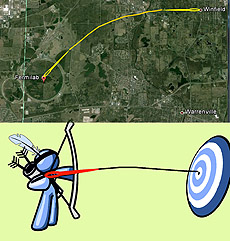Fixed-target vs. collider
 |
Particle collisions can be achieved in two different modes: fixed-target and collider. As depicted here, shooting a beam into a non-moving target is much easier than shooting two moving beams at each other, as is done in the collider mode. The precision of LHC collider-type collisions is equivalent to that of shooting one sewing needle from Fermilab and another from Winfield (six miles away) and having them collide in the middle. The very large improvement in collision energy is the reason we choose this difficult option.
|
Scientists have known how to accelerate charged particles for over a century. Take a battery, two pieces of metal and some wire, and voila, you have a simple accelerator.
However, once you've learned to accelerate subatomic particles, the next question is, "Well, now what?" Over the decades, we've learned that we can shoot beams of particles at targets and learn something about the universe by observing how the beams and the targets interact. There are two common ways to do these studies: fixed-target and collider.
In a fixed-target setup, the situation is simple. The particle beam is aimed at a large and stationary target. Such a stationary target might be a chunk of metal or some liquid hydrogen contained in a flask. The beam is much narrower than the target, and the target can be of any thickness. This setup is relatively easy. For one, it's easy to hit the target; my rural origins remind me of the phrase "as broad as a barn." For another, you can get as many collisions as you want by making the target thicker. Eventually, you can make the target so thick that the entire beam interacts with it. That choice would have some adverse consequences, but you could do it if you wanted to.
In the collider setup, the situation is technically much more challenging. Two beams are aimed at one another and made to collide. It's like using two guns to shoot bullets at one another with the hope that the bullets will hit head-on. Because the beams can be quite narrow, guaranteeing a collision requires incredibly accurate steering. To give a sense of scale, at the LHC the degree of precision required is equivalent to that of shooting toward each other two sewing needles separated by about six miles and having them collide at the halfway point. It is a very hard thing to do.
Given the relative straightforwardness of fixed-target operations and the difficulty of the collider version, why would anyone run an accelerator in collider mode? It's because of the useful energy available in a collision—it has much higher energy than what results from a fixed-target interaction. To get a sense of why, think of an automobile collision. Nobody wants to get into an accident, but if you had to, it would be better to drive your car into a parked car than to hit a moving car head-on. The collision with a parked car is less likely to result in injury. In contrast, a head-on collision with a moving vehicle can demolish both cars.
To put some numbers to the difference between the two modes: Suppose you ran an LHC beam into a stationary target and compared the impact to that of a real LHC collision, in which the two beams hit head-on. In one case you have two beams, while in the other you have only one, so you might think the "collider" collision is twice as violent as the "fixed-target" version. However, the "collider" collision is actually nearly 90 times more powerful. It is for this reason that researchers studying at the Energy Frontier will continue to make the particle collider their tool of choice.
—Don Lincoln
Want a phrase defined? Have a question? E-mail today@fnal.gov.
|